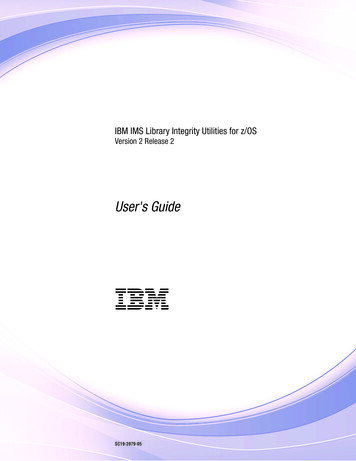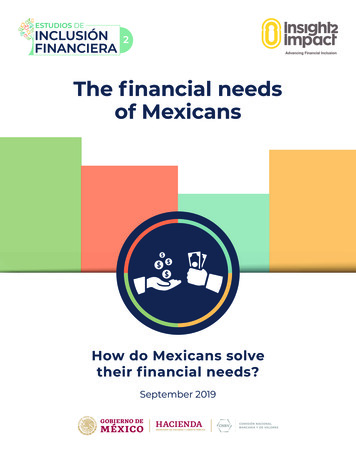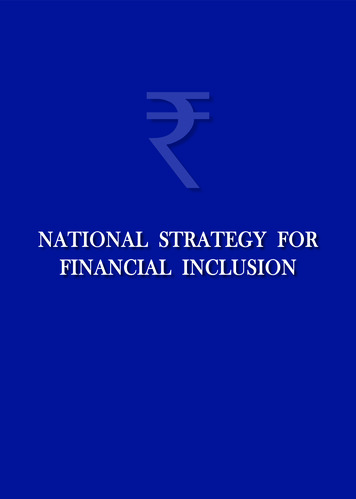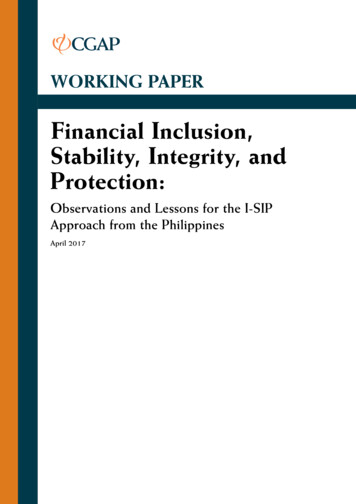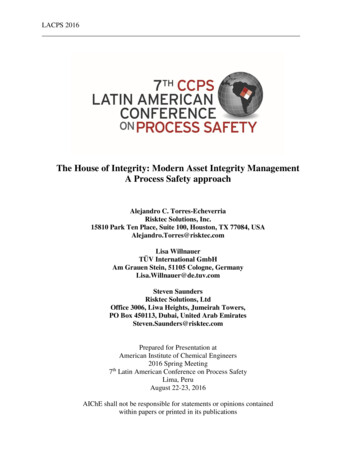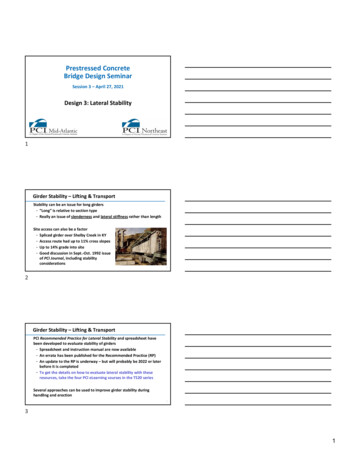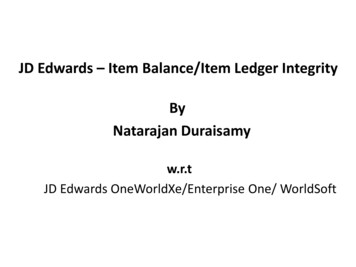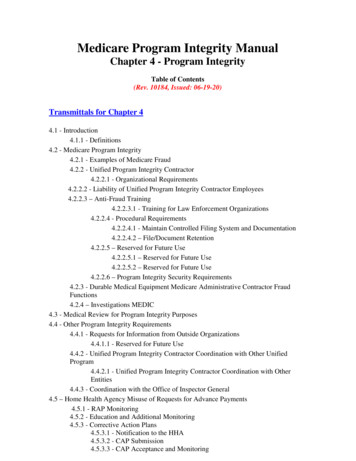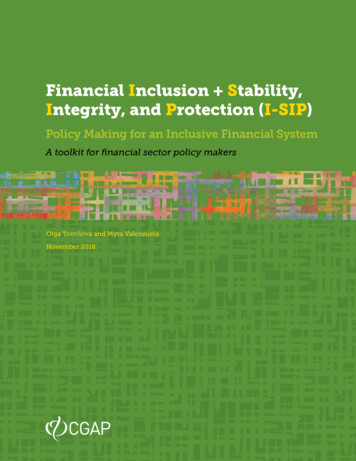
Transcription
Financial Inclusion Stability,Integrity, and Protection (I-SIP)Policy Making for an Inclusive Financial SystemA toolkit for financial sector policy makersOlga Tomilova and Myra ValenzuelaNovember 2018A
How can this toolkit help you?You are reading this toolkit because you have important policy decisionsto make. But you also face serious questions or problems to solve.Inclusion Your institution wants to address financial inclusion, but you haveother objectives that concern you: stability, integrity, and protection. Your institution often makes decisions based on intuition, but you areconcerned about unintended consequences. In your organization, it is difficult to establish a structured process inyour organization that will enable you to have a proper evaluation ordiscussion of a key policy issue.StabilityIntegrity You are facing an increasingly fast-changing and complex financiallandscape and have little time to assess a proposed policy intervention.These and other barriers may be making it hard for you to make progress.This Toolkit is designed from real-world experiences to take you througha structured process to arrive at policy decisions and to effectivelyimplement them.While this is not a formula that guarantees success, the process has beenused in multiple policy-making environments and has often led to goodpolicy outcomes.ACKNOWLEDGMENTSProtectionThe original I-SIP concept was developed by Martin Alsop (United Kingdom Department for International Development),Timothy Lyman (CGAP), and David Porteous (BFA). The authors wish to thank CGAP colleagues Gregory Chen, JuanCarlos Izaguirre, Stella Dawson, Kate Lauer, Timothy Lyman, Claudia McKay, Anna Nunan, and Stefan Staschen for theirguidance and support in the development of this publication.RIGHTS AND PERMISSIONS1818 H Street NW, MSN IS7-700Washington DC 20433Internet: www.cgap.orgEmail: cgap@worldbank.orgTelephone: 1 202 473 9594IIThis work is available under the Creative Commons Attribution 4.0 International Public License (https://creativecommons.org/licenses/by/4.0/). Under the Creative Commons Attribution license, you are free to copy, distribute, transmit, andadapt this work, including for commercial purposes, under the following conditions:Attribution—Cite the work as follows: Tomilova, Olga, and Myra Valenzuela. 2018. “Financial Inclusion Stability, Integrity,and Protection (I-SIP): Policy Making for an Inclusive Financial System.” Technical Guide. Washington, D.C.: CGAP.Translations—If you create a translation of this work, add the following disclaimer along with the attribution: Thistranslation was not created by CGAP and should not be considered an official translation. CGAP shall not be liable for anycontent or error in this translation.Adaptations—If you create an adaptation of this work, please add the following disclaimer along with the attribution: Thisis an adaptation of an original work by CGAP/World Bank. Views and opinions expressed in the adaptation are the soleresponsibility of the author or authors of the adaptation and are not endorsed by CGAP/World Bank.All queries on rights and licenses should be addressed to CGAP Publications, 1818 H Street, NW, MSN IS7-700, Washington,DC 20433 USA; e-mail: cgap@worldbank.org
A quick take:The I-SIP Approach in actionJasmine is a financial services regulator in Country X. She has long beenconcerned about the high use of informal cross-border remittancechannels. The people using these channels are financially excluded,and the channel’s informality diminishes financial integrity and poses higherrisks of money laundering and terrorist financing.About a year ago, she and her colleagues tried to apply a structuredframework that balanced the four key financial sector objectives—inclusion,stability, integrity, and consumer protection (I-SIP). They introduced a newcategory of remittance services providers that would be limited to the retailmarket, and would not have to be linked to an authorized dealer. Theyalso lightened several other requirements for this new provider category,to encourage more remittance services providers to formalize theirservices. Jasmine realized that lighter entry requirements had the potentialto adversely affect stability, but thought that this would be mitigated byincreased financial inclusion and giving a “green light” for integrity, becauseincreased use of formal channels was expected to significantly reduce thenumber of untraceable transactions.What has changed in one year’s time? Jasmine is reviewing the latest reporton the state of the remittance sector: 12 providers have applied for licenses,and four licenses have already been granted. The number of customers usingthese formal remittance channels grew by 20 percent, and the estimatedvolume of informal cross-border remittances was reduced by 15 percent.Jasmine is satisfied with these initial results, but she knows she needs to keepher finger on the pulse of any further developments to be able to swiftlyrespond to changes in the sector and evolving policy priorities.III
ContentsOVERVIEW OF THE I-SIP APPROACH1 What is I-SIP?2 The basics4 How to use this toolkit7FOUR THINGS TO CONSIDER AS YOU START9Applied across the implementation of the I-SIP ApproachI. Working definitions of the I-SIP objectives11II. Appropriate data13III. Consultation and collaboration14IV. Integration into existing policy making processes18THE SEVEN-STEP PROCESS19Identifying and managing the linkages between the I-SIP objectives1. Agree on the main goals of the policy intervention212. Identify measurable indicators for the I-SIP objectives233. Set targets264. Develop hypotheses for direct effects and linkages295. Evaluate the materiality of direct effects and linkages326. Implement the policy intervention347. Monitor and adapt36ANNEXES39Detailed information and links to other resourcesA. Policy interventions: Examples41B. I-SIP objectives: Linkages43C. I-SIP objectives: Definitions and Elements47D. Data: Resources51E. Consultation and collaboration: Process design tools53F. Indicators: Examples55G. Proportionality: Resources62WORKBOOK69Document your thinking and apply the I-SIP ApproachIV
Overview of theI-SIP Approach What is I-SIP? The basics How to use this toolkit1
What is I-SIP?Financial sector policy makers and international standard-setting bodies (SSBs) have traditionallypursued the core objectives of financial stability, financial integrity (i.e., preventing financialcrimes), and financial consumer protection. In 2010, the G20 leaders recognized and endorsedfinancial inclusion as a pillar of the global development agenda and recognized its interrelationswith the three other objectives. The leaders also called on SSBs1 to deepen the work in this areaupon the creation of the G20 Global Partnership for Financial Inclusion. As a result, these SSBshave included the financial inclusion angle into their guidance, consistent with their coremandates, and have increasingly been working together to address cross-cutting issues relevantto financial inclusion.As of 2018, the number of countries publicly committed to promoting financial inclusion tops90 and continues to grow.2 Many of these countries’ financial regulators and supervisors3 areexplicitly tasked with implementing policies and strategies on financial inclusion (I) alongsidetheir core responsibilities for promoting micro- and macroprudential stability (S), financialintegrity (I), and protecting financial consumers (P), collectively referred to as I-SIP.4There can be other objectives beyond I-SIP.Often the I-SIP objectives are not pursued fortheir own sake, but rather as enablers of broadersocietal ends, such as fostering competition,generating employment, alleviating poverty,reducing inequality, or spurring more inclusiveeconomic growth. Although competition couldalso be considered an objective on its own and isimplicitly intertwined with the other I-SIP objectives, it will not be explored in this toolkit.2
Why are the four I-SIP objectives important?INCLUSION“Financial inclusion efforts seek to ensure that all households and businesses, regardless ofincome level, have access to and can effectively use the appropriate financial services they needto improve their lives. The potential benefits of financial inclusion are not only significant forindividuals but for economies as well. Financial inclusion is linked to a country’s economic andsocial development and plays a role in reducing extreme poverty. Research indicates that financialinclusion is not only positively correlated with growth and employment, but it is generally believedto causally impact growth.”5STABILITYFinancial stability is important because it is a key contributor to price stability and positively affectsthe real economy in other ways as well. A stable financial system is also important because itreinforces trust in the system. It prevents phenomena such as a run on banks, which can destabilizean economy. A sound financial system signals to the public that their money is handled in a waythat will not unduly jeopardize it. This is especially important for savings, including pensionsavings.6INTEGRITY“[M]oney laundering, terrorist financing, and related crimes to the integrity and stability of thefinancial sector and the broader economy can discourage foreign investment and distortinternational capital flows. They may also result in welfare losses, draining resources from moreproductive economic activities, and even have destabilizing effects on other countries. In anincreasingly interconnected world, the harm done by these activities is global.”7PROTECTION“Robust consumer protection in financial services and financial literacy and capability are neededto (i) ensure that financial markets are deep and serve the broad population, (ii) provide access tofinancial services for low-income households, and (iii) ensure long-term stability in the financialsystem. Strong consumer protection and financial literacy are building blocks for financialmarkets. They help to build consumer trust in financial institutions and ensure that financialinstitutions serve the needs of the population, including low-income households, which oftenlack access to basic financial services.”83
The basicsThis Toolkit provides a structured approach for manag-These six pairs of linkages highlight the relativeing the complex interplay among the I-SIP objectives—risks and benefits across the four objectives. Bythe I-SIP Approach—based on extensive analysis of howanalyzing these pairs, policy makers can developcountries have managed the interrelations, or linkages,balanced, proportionate policy interventions, oramong these four objectives.adjust existing ones, taking into account their significance for the financial system as a whole.For effective policy making, consider all four I-SIPobjectives. Inclusion, stability, integrity, and protectionare interrelated, and under the right circumstances, areSIX PAIRS OF THE LINKAGES AMONGTHE I-SIP OBJECTIVESmutually reinforcing. While each of these objectives is1INCLUSIONgc STABILITY2INCLUSIONgc INTEGRITY3INCLUSIONgc PROTECTIONThe main idea of the I-SIP Approach is to identify4STABILITYlinkages between these objectives and manage these5INTEGRITY6PROTECTIONvaluable on its own, failing on one objective can lead toproblems with others—this is why it is important to getall of them right.linkages to design policies that lead to improved outcomes, where synergies between the objectives aregc INTEGRITYgc PROTECTIONgc STABILITYmaximized, and any trade-offs or negative outcomesavoided or minimized.The pair-wise analysis is a necessary simplificationof real-world policy making. While such pair-wiseanalysis can be conducted using each pair of theThe I-SIP Approach will help you break down the com-four I-SIP objectives, policy makers must manageplex linkages among the I-SIP objectives into manage-all four objectives at the same time. They cannotable pieces. This is done by analyzing the direct effectmake decisions based on a simple two-dimen-of a policy intervention on one of the I-SIP objectivessional grid. Moreover, a given policy interventionand the linkages it triggers between pairs of the I-SIPwill have different potential effects on each of theobjectives (e.g., inclusion and stability, or inclusion andfour objectives, depending on the specific countryprotection). The resulting six pairs of objectives provide acontext, and the linkages among them will evolveholistic picture of how the objectives affect each other.over time.[ See Annex A for examples of specificpolicy interventions that have beenanalyzed using the I-SIP Approach.4
Impact on financial ade-offAnalyzing direct effects and linkages. The I-SIP Approachan I-SIP objective and the potential synergies and tradeoffs that this effect might trigger between each pair ofthe four I-SIP objectives, such as inclusion and stability,or stability and protection. This Toolkit focuses on identifying and managing the linkages among I-SIP objectives.There are three possible classes of linkages for each pairof the I-SIP objectives: Negative. A trade-off, where one objective is achievedat the cost of the other.Impact on financial stabilityassesses the direct effect(s) a policy intervention has stabilityreducing Neutral. When there is no effect on the objectives. Positive. A synergy, where achieving one supportsZone of synergy between the objectivesachieving the other objective.One objective is achieved without negatively impacting anotherPolicies that would have no effect on either objectiveTrade-off zones between the objectivesZones where there is loss for no gainA direct effect is a change relating to one of[ See Annex B for examples of positive andthe I-SIP objectives that is directly caused bynegative linkages between the six pairs ofthe policy intervention. For example, a changethe I-SIP objectives.in a stability-linked prudential rule (e.g., lowering minimum capital requirements) has a directeffect on stability, yet the primary objective ofthe change might be to advance financial inclusion (on the assumption that there is a linkagebetween lower barriers to entry and financialinclusion).5
How do linkages between the I-SIP objectives work at a big-picture level?Examples of possible synergiesExamples of possible trade-offs and negative linkagesINCLUSION gc STABILITYDIVERSIFICATION. An inclusive financial sector has a diversified, stable retail deposit base that increases financial stability. Similarly,financial inclusion may help lenders diversify their loan portfolio,mitigate credit risk, and reduce dependence on large borrowers,thus reducing potential systemic risk.PRESSURES ON SUPERVISORY CAPACITY. Allowing new categories ofproviders (e.g., deposit-taking microfinance institutions) to increasefinancial inclusion puts pressure on the supervisory authority becauseof additional responsibilities. Relaxing prudential or consumer protection requirements for a new class of providers introduces ways toarbitrage the existing tiers of regulatory requirements. It may eventhreaten stability because of the large exposure between existing andnew tiers that is not well understood or managed.INCLUSION gc INTEGRITYGREATER TRACEABILITY OF TRANSACTIONS. As more people enterinto the formal financial sector and leave the untraceable casheconomy, more transactions are traceable and electronic. These aremonitored and reported by formal financial institutions.AML/CFT COMPLIANCE ENTAILS COSTS. Compliance with AML/CFTrequirements is burdensome and costly for financial services providers, particularly in countries without ID systems that cover thepoor, leading to a decrease in customers’ access.INCLUSION gc PROTECTIONIMPROVED PROTECTION AND REDUCING RISKS TO CONSUMERS OFUNREGULATED PROVIDERS. Increased inclusion often means in-creased consumer protection because formal providers are morelikely to be subject to effective consumer protection regulation thaninformal providers. Effective access to regulated financial servicesallows households to avoid potential abuse and fraud by unscrupulous providers in the informal sector.NEW TECHNOLOGY MAY POSE RISKS TO CONSUMERS. Using newtechnology may raise consumer protection challenges, such ascompromised personal identification numbers (PINs) or fund transfer errors, and first-time users may face technology challenges. Ifuse of the new technology scales fast, existing measures for protection may be inadequate.STABILITY gc INTEGRITYTRUST BUILDING AND FINANCIAL SYSTEM STRENGTHENING. Reduc-DE-RISKING. Larger global banks may terminate or severely restricttion in and prevention of financial crime builds public confidence inthe financial system and helps to make the system stronger andmore secure.their relationships (e.g., curtail products or services) with certain categories of clients or countries because of perceived AML/CFT risksand compliance costs. Among other adverse consequences, thismay affect the ability to send and receive international payments, ordrive some payment flows underground, with potential negativeconsequences on growth, financial inclusion, stability, and integrityof the financial system.INTEGRITY gc PROTECTIONIMPROVED PROTECTION THROUGH FORMALIZATION. Use of formalregulated and supervised channels supports improved consumerprotection against fraud, financial abuse, and exploitation.CUSTOMER DUE DILIGENCE REQUIREMENTS UNADJUSTED FOR CONTEXT CAN UNDERMINE CONSUMER PROTECTION. Overly strict cus-tomer due diligence requirements set forth for lower-incomeconsumers or those lacking formal ID documents may drive theseconsumers out of the formal regulated and supervised financial services and channels and into the informal market where they are notprotected against fraud, financial abuse, and exploitation.PROTECTION gc STABILITYSOUND INSTITUTIONS BETTER PROTECT CLIENTS. Prudentially regu-lated institutions protect their clients’ savings and are more likely tobe subject to consumer protection regulation.CONSUMER PROTECTION ISSUES IN LENDING CAN NEGATIVELY IMPACTSTABILITY. Consumer over-indebtedness can affect the financialsolvency of providers if it leads to a deterioration in the quality oftheir loan portfolios. This may also cause a systemic risk if it leads toa general slump in repayment discipline and thus negatively affectsthe stability of the banking sector.[ See Annex B for more examples of positive and negative linkages between the I-SIP objectives.6
How to use the ToolkitThis Toolkit is for policy makers who design new policy interventions, amend existing ones, or assess theeffects of implementing regulations with a financial inclusion dimension, while simultaneously consideringthe other core policy objectives. Other users such as consultants and development organizations who workto support policy makers may find it useful as well.Use this approach to analyze both new and existingApply the four considerations before jumping to thepolicies. The I-SIP Approach should be applied to spe-seven-step implementation process. Each consider-cific policy interventions (ranging from laws and regula-ation may be relevant at different stages of the imple-tions to guidance)—either planned (ex-ante) or existingmentation process.ones (ex-post), as well as at different stages of these policy interventions (from proposals of policies to revisionsUse the worksheets in the last section of the Toolkitof existing ones).to document your thinking and apply the approach toyour own policy interventions.Use it as a framework for systematically thinkingthrough the issues; it is not intended to be a preciseformula for success. Policy making is as much an art asa science, and every country’s situation and policy priori-The seven-step implementation process and four considerations to beapplied along the wayties are unique and differ from each other. This approachis designed to help you understand the complex inter-1relationships among the four I-SIP objectives—inclusion,Agree onmain goalsstability, integrity, and protection and make informeddecisions for managing them—not to arrive at scientific2conclusions.7Adapt the I-SIP Approach to your country context. ThisMonitorand adaptToolkit features real-life examples where country namesare intentionally omitted to underscore that countryIWorking definitionscontext is crucial. One country’s experiences shouldnot be used as a template for another country withoutIIaccounting for country-specific factors, such as marketAppropriate datastructure, regulatory framework, and capacity and constraints of supervisors.IdentifyindicatorsFour considerations6Implementpolicy3IIIConsultation and collaborationSettargetsIVIntegration into existingpolicy-making processes5Evaluatemateriality ofdirect effectsand links4Develophypotheses fordirect effectsand links7
8
Four things toconsider as you startI. Working definitions of the I-SIP objectivesII. Appropriate dataIII. Consultation and collaborationIV. Integration into existing policy making processes9
OverviewTo get the best results from the I-SIP Approach, the following considerations should be appliedacross the seven-step process. At each step, icons indicate which considerations apply.Working definitions of the I-SIP objectivesAppropriate dataConsultation and collaborationIntegration into existing policy-making processes10
I. Working definitions of the I-SIP objectivesEnsure you know what each of the I-SIP objectives means. Working definitions for objectives will helpyou to (i) have a common conceptual and strategic understanding of the objectives and their potentialeffects; (ii) decide what indicators may help you measure the effects of the policy intervention; and (iii)see potential gaps in the policy intervention.You may need to come up with your own working definitions for these objectives because there areno globally accepted and comprehensive definitions of the I-SIP objectives, and those you may havein your country may not be appropriately defined for a particular policy intervention. Financial sectorsaround the world are multidimensional and continuously evolving, as are the various dimensions ofthese objectives. Use evolving global standards as guidance. As youregulator or other financial sector authorities. Youwill see from examples that follow, internationalalso may reference what other countries have done,organizations provide some ideas about what makesbut make sure to adjust definitions used by otherup the concepts of inclusion, stability, integrity, andcountries to apply to your country’s context.protection. Use these resources to build your understanding of the I-SIP objectives and align your work- tions! If there are no existing definitions that fit youring definitions. Be prepared to develop your own working definineeds (e.g., national definitions may have been devel-Check if your country has already defined the I-SIPoped with other objectives in mind), you will need toobjectives. Possible sources of information includecreate your own working definitions.your country’s national financial inclusion strategy,if one exists, for a definition of financial inclusion,though it may need to be adjusted to fit your policyintervention. For help defining the other objectives,refer to documents such as your country’s financialstability report from your country’s financial sector Ensure your definitions are appropriately comprehensive and specific. Key elements of each objective should be identified and addressed to allow youto measure the effects of your policy interventionagainst the objectives.11
Key elements to considerEach I-SIP objective is multidimensional. Breaking down the I-SIP objectives into their key elements will help yousharpen the goals of your policy intervention and select indicators to measure the effects of the policy intervention.INCLUSION9 Access to financial services Usage of financial services Quality of products andservice delivery Impact of financial inclusionon households’ and firms’outcomesSTABILITY10Stability (no disturbances,resistance to shocks) in: Financial infrastructure Financial institutions Financial marketsINTEGRITY11,12 Assessment, understanding,management, and mitigationof money laundering/financing of terrorism risks Customer acceptance policy Customer and beneficialowner identification,verification, and risk profiling Ongoing monitoring Information management Reporting of suspicioustransactions and frozenassets[ See Annex C for more resources on defining the I-SIP objectives.12PROTECTION13 Disclosure and transparency Fair treatment and businessconduct Data protection and privacy Dispute resolutionmechanisms Guarantee schemes andinsolvency Financial capability
II. Appropriate dataThink creatively and pragmatically about what data you will need to monitor the effects of the policyintervention, to manage the linkages among the I-SIP objectives, and to track progress in reaching yourtargets and indicators.Different countries and policy interventions are likely to require different indicators and associated datato measure the achievement of the I-SIP objectives and manage the linkages among the objectives. Collaborate with other departments and publicagencies. The first place to look for data is your ownagency, because supervisory authorities gather a lot ofdata on regulated financial institutions (e.g., throughregulatory returns). However, reporting among a regulator’s departments often is uneven, so it’s importantto collaborate with all that might have relevant datato find what you need. Other public agencies, evenoutside the financial sector regulators (such as thetelecommunications ministry), may also collect relevant data. WHAT IF THERE ARE NOT ENOUGH DATA,OR IF THERE IS LIMITED CAPACITY TOCOLLECT DATA?One country demonstrated the value of thinkingcreatively in this situation. When the countrydrafted its regulations on nonbank financialinstitutions (NBFI), it was difficult to collect comprehensive data on all aspects of the NBFIs’operations because there were over 6,000 ofthem, and the regulatory and supervisoryEstablish baselines and collect data regularly. Ide-authority had limited supervisory capacity. Toally, data should be gathered before policy is imple-overcome this hurdle, the regulator combinedmented. This creates a baseline from which toexisting database information on NBFIs’ activitiesmonitor the policy’s effects on the I-SIP objectives.with findings from an inspection that examinedData should then be regularly collected and analyzed10 percent of them, to inform a comprehensiveto track progress and to allow you to make propor-set of draft regulations that addressed majortionate adjustments when necessary.risks. This approach, however, did not eliminateUse soft data if there are no hard data. In the absenceof “hard” (quantitative) data, “soft” (qualitative) dataare better than no data at all. Soft data include inter-the need to collect the necessary data on NBFIs’operations moving forward to evaluate theeffect of the draft regulations.views with policy makers, regulators, financial services providers, and other market stakeholders whohave insights into how a specific policy change hasaffected the achievement of the I-SIP objectives and[ See Annex D for data sources.the linkages among them. Interviews with consumers of financial services can also be useful. Think creatively for good proxies of the data needed. Concentrate on quality not quantity. Having moredata is not always better. Prioritize which data arecritical to monitoring the effects of the policy intervention in question, managing the linkages, andtracking progress.13
III. Consultation and collaborationConsult widely and regularly with a range of internal and external stakeholders, to get a range of viewson possible effects of the policy intervention on the I-SIP objectives and to develop measurable indicators. Collaborate with other agencies to ensure your policy interventions are aligned with theirs. Consider stakeholder mapping. Stakeholder map-Within agencies, regulators often form task forces orping will help identify which stakeholders are mosttechnical teams with members from different depart-useful to engage with and to what degree, as well asments. For inter-agency collaboration, this could takewhich of them is likely to support or oppose the pol-the form of a steering committee or another type oficy intervention.coordinating body.Consult widely, yet proportionately. Many coun- Get providers’ perspectives on likely market re-tries have a mandatory consultation process, but thissponses. Consulting with financial services provid-may not be adequate or sufficient, depending on theers will help you better understand the likely marketnature of the policy intervention. A broad spectrumresponse to regulatory changes, surface new insights,of stakeholders across the supply chain—from regu-and reduce the risk of unintended consequences.lators and providers to consumers—may need to beExplore the providers’ views on how the proposedconsulted. As with data, the degree of consultationpolicy intervention could affect their operations. Forshould be proportionate to the likely scale and effectexample, what impact might it have on their com-of the policy intervention.pliance costs, operational model, incentives to servecertain consumer groups, and product mix? TheConsult and collaborate at an inter- and intra-agen-providers with whom you consult ultimately will becy level. This is necessary since responsibility for eachdecided by the nature of the policy intervention.of the I-SIP objectives likely rests across various publicSometimes, it might be more efficient to work withagencies or various department
The I-SIP Approach will help you break down the com-plex linkages among the I-SIP objectives into manage-able pieces. This is done by analyzing the direct effect of a policy intervention on one of the I-SIP objectives and the linkages it triggers between pairs of the I-SIP objectives (e.g., inclusion and stability, or inclusion and protection).
